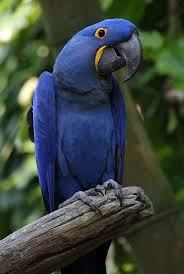Hyacinth Macaw

Description
The hyacinth macaw (Anodorhynchus hyacinthinus), or hyacinthine macaw, is a parrot native to central and eastern South America. With a length (from the top of its head to the tip of its long pointed tail) of about 100 cm (3.3 ft) it is longer than any other species of parrot. It is the largest macaw and the largest flying parrot species, though the flightless kakapo of New Zealand can outweigh it at up to 3.5 kg. While generally easily recognized, it can be confused with the far rarer and smaller Lear's macaw. Habitat loss and the trapping of wild birds for the pet trade have taken a heavy toll on their population in the wild, so the species is classified as Vulnerable on the International Union for Conservation of Nature's Red List, and it is protected by its listing on Appendix I of the Convention on International Trade in Endangered Species of Wild Fauna and Flora (CITES).
The largest parrot by length in the world, the hyacinth macaw is 100 cm (3.3 ft) long from the tip of its tail to the top of its head and weighs 1.2–1.7 kg (2.6–3.7 lb). Each wing is 388–425 mm (15.3–16.7 in) long.The tail is long and pointed. Its feathers are entirely blue, lighter above. However, the neck feathers can sometimes be slightly grey.
Scientific Name
Anodorhynchus Hyacinthinus
Country Of Origin
Size
Life Expectancy
Noise Level
Loud
Talk / Trick Ability
Very Good
Characteristics
These big, beautiful birds love to cuddle, but also need playtime on their own. While hyacinth macaws are playful, loving and sweet pet birds, they can also be demanding and headstrong. Hyacinth macaws will play with anything, sing, hop around, toss their toys from the playgym as if they’re King Kong, and then appreciate a nice round of applause. Their large size should not be mistaken for a lack of love and affection. On the contrary, the hyacinth macaw, the largest of the macaws, enjoys cuddling and showing affection. This pet bird can be loud and likes to destroy their toys, so be prepared to have plenty on hand. The hyacinth macaw is known for lunging forward, but that action should not be misinterpreted as aggression. Experienced owners suggest hanging a large, Swiss wooden cow bell to provide hours of entertainment for your macaw.
Behavior / Health Concerns
Chewing and biting are common behavior problems among hyacinth macaws. Over-stimulation during an activity might cause an unnecessary bite. They are prolific chewers and susceptible to overgrown beaks, so provide wood and other hard toys to give their beaks a work out. They are also susceptible to papillomas, proventricular dilatation disease (PDD, also known as “macaw wasting” disease), polyomavirus, psittacosis and vitamin-A sensitivity. Exposure to natural sunlight is also important. Because of their size and activity level, hyacinth macaws require a higher fat and higher carbohydrate diet than other macaws. Macadamia nuts should be included in their base diet of pellets, fresh fruits, vegetables and whole grains. Owners often face the challenge of keeping up with their active hyacinth macaws.
Expert Advice
“Rowdy, loving, intelligent, LOUD and expensive!”
Liz Wilson, CVT, CPBC
“The king of the macaw family and the largest of the macaw, also the absolute sweetest of the macaw family. Their huge heads and beak are formidable, however, they very rarely are aggressive. These are my favorite macaws to work with, partly due to their great disposition and more importantly their majesty. Must have high-fat nuts, preferably palm nuts, in their diets.”
Samuel Vaughn, DVM, Dip. ABVP – Avian Practice